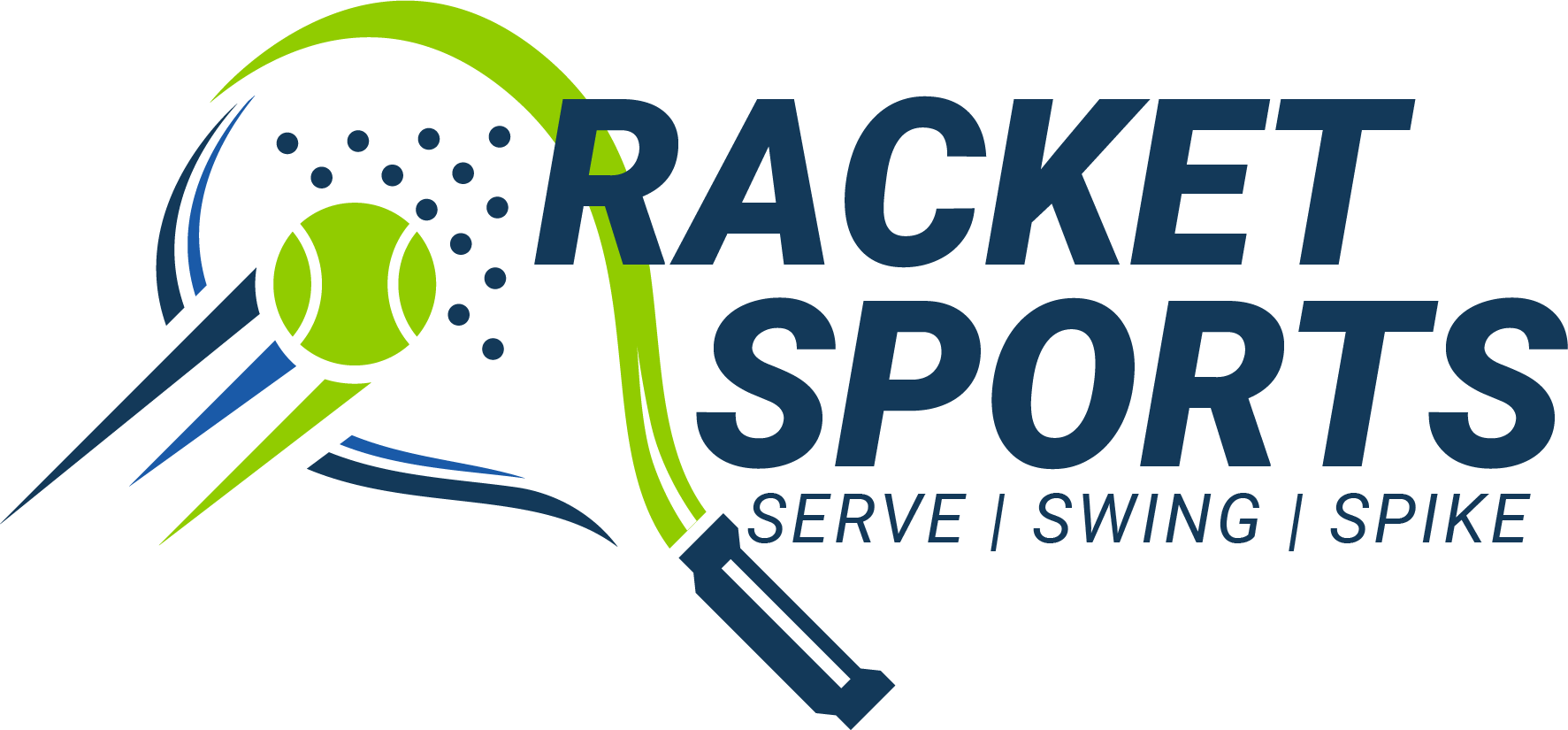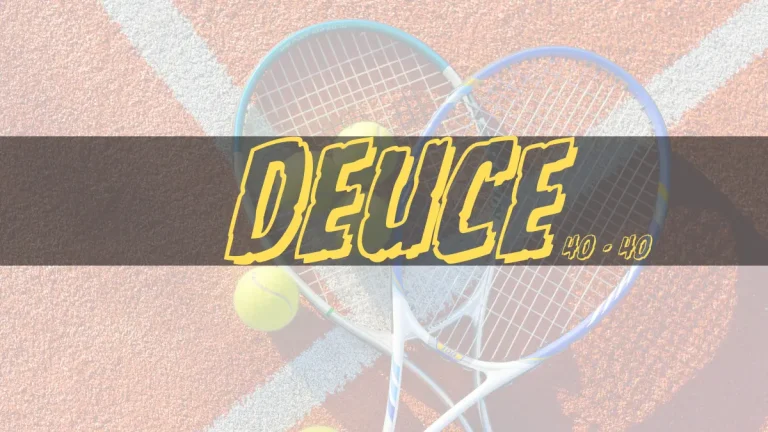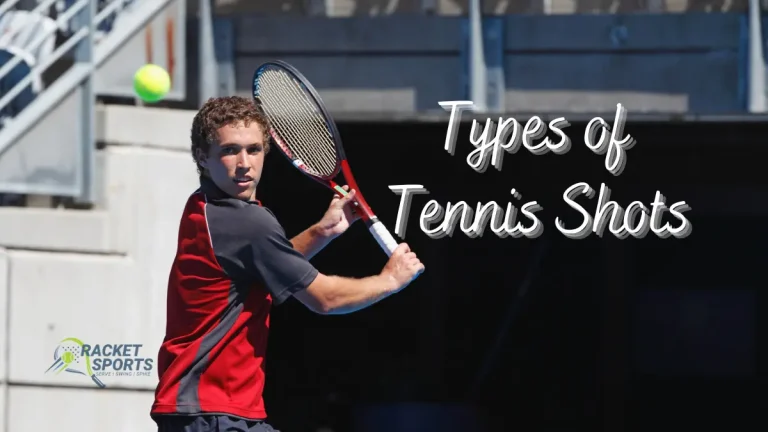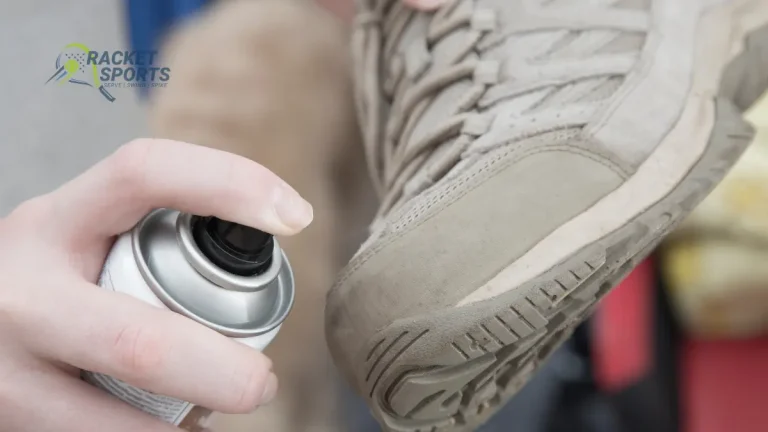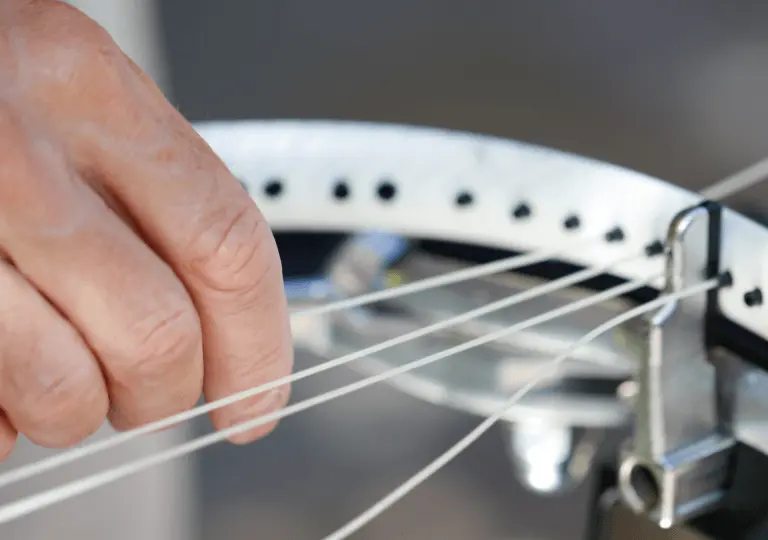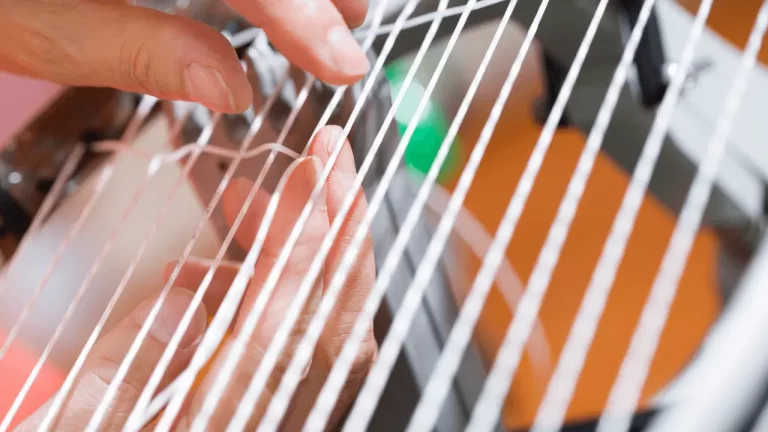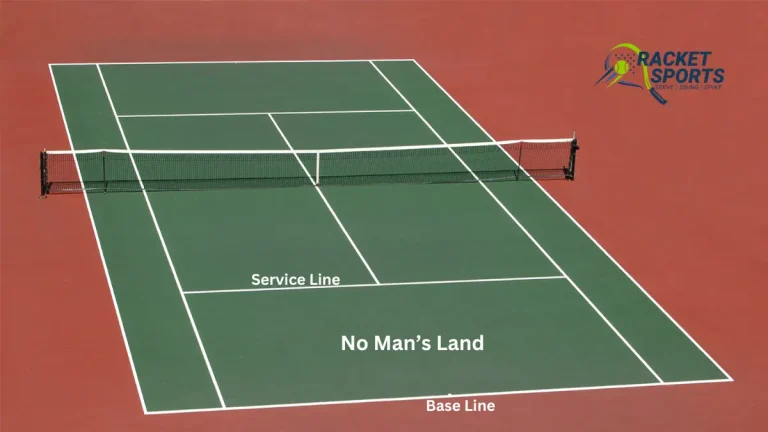Top 9 Best Tennis Shoes for Men – Ultimate Picks 2025
Finding Your Perfect Court Companion
Selecting the ideal tennis shoes isn’t just about style – it’s a pivotal decision that can significantly influence your performance on the court. Whether you’re engaging in a friendly match or competing at a professional level, the right footwear serves as your foundation, offering the support and agility needed for every serve, volley, and sprint.
The Top 9 Best Tennis Shoes for Men are meticulously designed to provide:
- Stability: Ensuring your feet remain grounded during rapid lateral movements.
- Durability: Withstanding the rigors of intense matches and varied court surfaces.
- Court-Specific Traction: Offering grip tailored to hard, clay, or grass courts.
- Comfort: Keeping your feet cushioned and supported throughout prolonged play.
Unlike generic sneakers, tennis-specific shoes are engineered to handle the sport’s unique demands, protecting against the quick pivots and explosive movements that define the game.
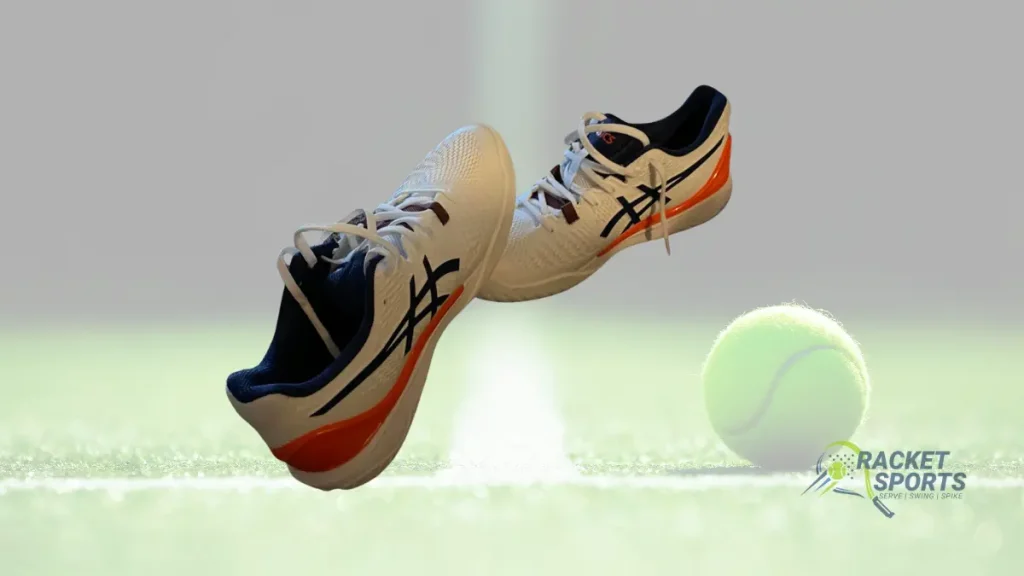
The Critical Role of Proper Tennis Footwear
Tennis is a dynamic sport, characterized by swift directional changes, sudden stops, and powerful accelerations. Such movements place immense stress on your feet and ankles. Wearing shoes not designed for these actions can lead to:
- Increased Injury Risk: Inadequate support can result in sprains, strains, or more severe injuries.
- Reduced Performance: Lack of proper cushioning and grip can hinder your agility and speed.
Proper tennis shoes address these concerns by incorporating features like reinforced toe caps, torsional support, and abrasion-resistant outsoles. These elements work together to provide the necessary stability and protection, allowing you to focus on your game without distraction.
Common Pain Points Tennis Players Face
Even with the best equipment, tennis players often encounter foot-related issues. Some prevalent problems include:
- Blisters: Caused by friction between the foot and shoe, especially during intense matches.
- Arch Fatigue: Resulting from inadequate arch support, leading to discomfort and decreased performance.
- Premature Sole Wear: Accelerated by frequent play on abrasive surfaces, reducing the shoe’s lifespan.
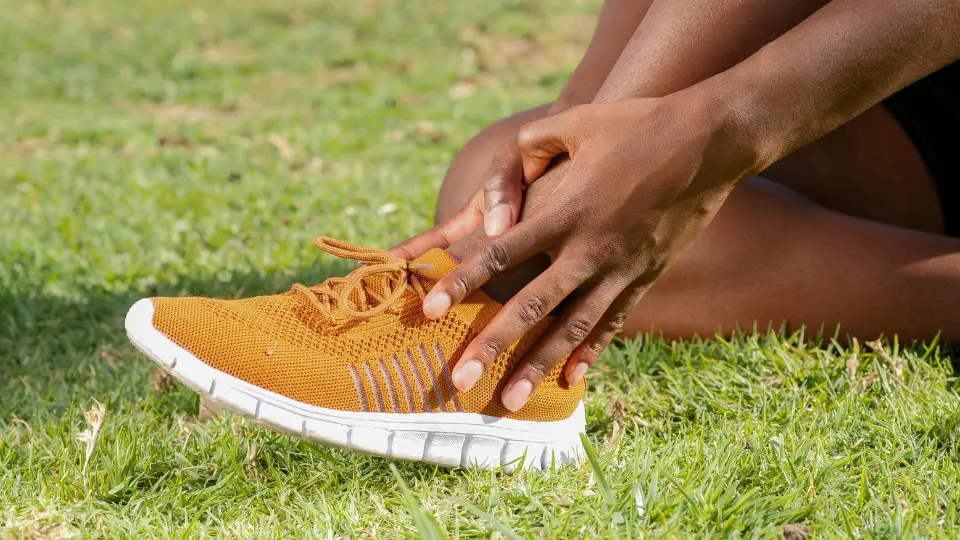
To combat these issues, modern tennis shoes incorporate:
- Strategic Cushioning: Targeted padding to absorb shock and reduce pressure points.
- Breathable, Moisture-Wicking Liners: Keeping feet dry and minimizing friction.
- Surface-Adapted Tread Patterns: Enhancing grip and distributing wear evenly across the sole.
By addressing these common pain points, the right tennis shoes not only enhance performance but also contribute to overall foot health, ensuring you remain at the top of your game.
Our Quick Picks
| Sr # | Product | Brand | Sole | Outer | Origin | Check Price |
|---|---|---|---|---|---|---|
| 1 | Nike Air Zoom Vapor Pro 2 | Nike | Synthetic Rubber | Durable | Imported | CHECK ON AMAZON |
| 2 | adidas Men’s Barricade 13 | Adidas | Rubber | Rubber | Imported | CHECK ON AMAZON |
| 3 | ASICS Gel-Resolution 9 | ASICS | Rubber | Rubber | Made in USA | CHECK ON AMAZON |
| 4 | New Balance FuelCell 996v5 | New Balance | Rubber | Mesh | Imported | CHECK ON AMAZON |
| 5 | K-Swiss Hypercourt Supreme 2 | K-Swiss | Rubber | Synthetic | Imported | CHECK ON AMAZON |
| 6 | Babolat Propulse Fury 3 | Babolat | Rubber | Rubber | USA | CHECK ON AMAZON |
| 7 | Wilson Rush Pro 4.5 | Wilson | Rubber | Synthetic | Imported | CHECK ON AMAZON |
| 8 | On ROGER Pro 2 | ON | Rubber | Rubber | Imported | CHECK ON AMAZON |
| 9 | Lacoste AG-LT23 Ultra | Lacoste | Rubber | Thermoplastic Polyurethane (TPU) | Imported | CHECK ON AMAZON |
How We Tested and Selected the Best Tennis Shoes
Our Hands-On Testing Approach
When it comes to picking the right tennis shoes, we believe there’s no substitute for real-world experience. So, we rolled up our sleeves and put over 35 different models through their paces. Our diverse team—comprising college players, seasoned coaches, and foot health experts—spent more than 200 hours on the court, testing shoes on hard, clay, and grass surfaces.
We weren’t just looking for flashy designs or big brand names. We focused on how each pair felt during intense rallies, quick sprints, and those crucial match points. Our goal was to find shoes that offer the perfect blend of comfort, support, and performance.
What We Looked For
To ensure we covered all bases, we zeroed in on three key areas:
- Side-to-Side Support: Tennis demands a lot of lateral movement. We paid close attention to how well each shoe supported the foot during quick direction changes and slides, ensuring stability without sacrificing flexibility.
- Cushioning and Comfort: Long matches can be tough on the feet. We assessed the cushioning in the heel and forefoot areas, looking for shoes that absorb impact effectively and keep your feet feeling fresh, even after hours of play.
- Grip and Traction: Whether it’s a dusty clay court or a slick grass surface, grip is crucial. We tested how well each shoe maintained traction during rapid movements and pivots, ensuring you stay grounded when it matters most.
By combining our on-court experiences with insights from foot health professionals, we’ve curated a list of tennis shoes that cater to various playing styles and preferences. Whether you’re a baseline grinder or a serve-and-volley enthusiast, we’ve got recommendations to help you perform at your best.
Top 9 Best Tennis Shoes for Men in 2025
1. Asics Gel Resolution 9 – Best Overall Performance
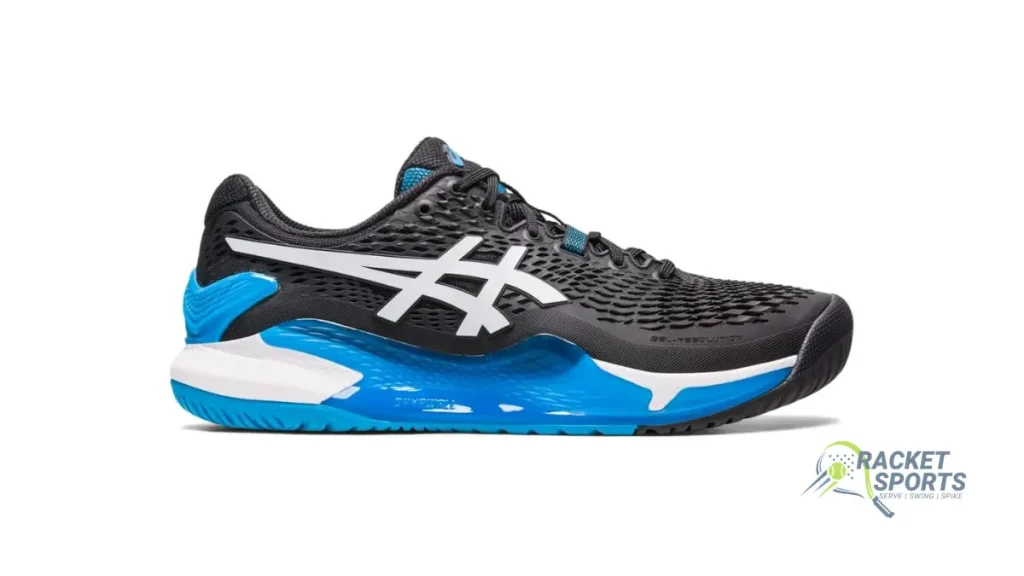
4.5
Specifications:
Key Features
- TWISTRUSS™ System: Prevents midfoot torsion for enhanced stability during lateral movements.
- DYNAWALL™ Technology: Offers superior lateral support and durability.
- Gel™ Cushioning: Absorbs shock and provides excellent comfort.
- Durable Outsole: Designed for extended wear on hard courts.
The Gel Resolution 9 continues Asics’ legacy of delivering exceptional performance on the court. Equipped with the TWISTRUSS system, it effectively prevents midfoot torsion, ensuring stability during lateral movements. The Gel cushioning pods absorb shocks, providing comfort during intense rallies. Dynawall+ technology enhances stability during aggressive lateral cuts.
The shoe features a durable outsole with a 20% longer lifespan compared to its predecessor, making it ideal for baseliners requiring ankle support during extended matches.
Ideal Player Profile
Ideal for: Baseline players who engage in long rallies and require exceptional ankle support and durability.
Pros & Cons:
2. Adidas Barricade 13 – Best for Stability
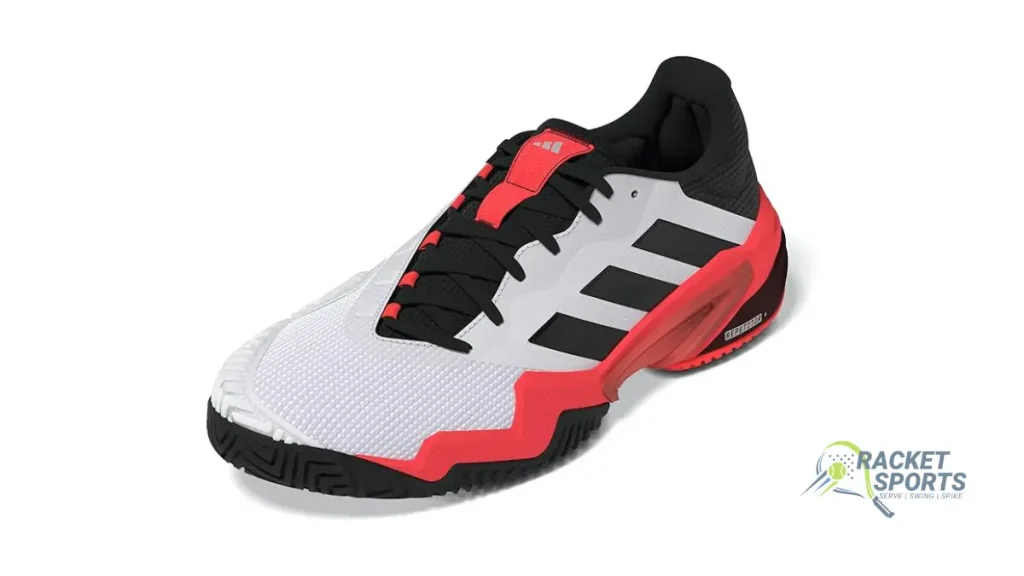
4.3
Specifications:
Key Features
- Geofit Collar: Cradles the ankle for a secure fit.
- Adiwear 6 Outsole: Provides exceptional durability and traction on hard courts.
- Adiprene+ Cushioning: Delivers responsive cushioning for energy return.
- Torsion System: Offers midfoot integrity and support.
The Barricade 13 is designed for players seeking unmatched stability. Its Geofit collar cradles the ankle, offering a secure fit, while the Adiwear 6 outsoles withstand drags on hard courts. The adiprene+ technology provides energy return, enhancing responsiveness during serves. This shoe is tailored for players who prioritize stability and durability during their matches.
Ideal for: Aggressive players seeking maximum stability and durability on hard courts.
Pros & Cons:
3. NikeCourt Air Zoom Vapor Pro 2 – Best for Speed

4.3
Specifications:
Key Features
- Zoom Air Unit: Provides responsive cushioning for quick movements.
- Low-Cut Design: Offers a lightweight and agile feel.
- Herringbone Outsole: Ensures optimal grip on hard courts.
- Internal Sleeve: Offers a snug, sock-like fit.
The Vapor Pro 2 is engineered for speed, weighing just 12.1oz. Its TPU shank enables quick direction changes, essential for agile players. The Drag-on toe guards prevent wear during toe drags, ensuring longevity. This shoe is perfect for players who value speed and agility on the court.
Ideal for: Quick movers and serve-and-volley players who prioritize lightweight footwear for rapid direction changes.
Pros & Cons:
4. New Balance FuelCell 996v5 – Best Cushioning
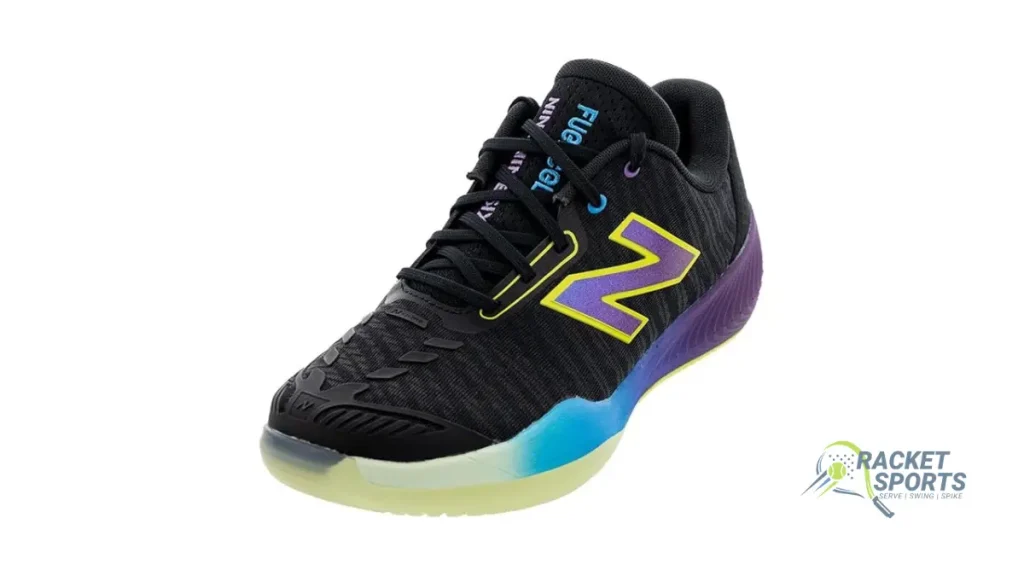
4.6
Specifications:
Key Features
- FuelCell Midsole: Delivers a propulsive feel to help drive you forward.
- Ndurance Rubber Outsole: Provides superior durability in high-wear areas.
- Lightweight Construction: Ensures comfort during long matches.
- Multiple Widths: Offers a customizable fit for various foot shapes.
The FuelCell 996v5 offers dual-density FuelCell foam, reducing knee strain for heavier players. The Ndurance rubber outsole extends tread life by 30%, ensuring durability.
Its lightweight design and responsive cushioning make it suitable for players seeking comfort during long matches. Endorsed by tennis star Sloane Stephens, this shoe is ideal for those prioritizing cushioning and support.
Ideal for: Players who value superior cushioning and comfort, especially beneficial for those with a history of injuries.
Pros & Cons:
5. Babolat Propulse Fury 3 – Best for Durability
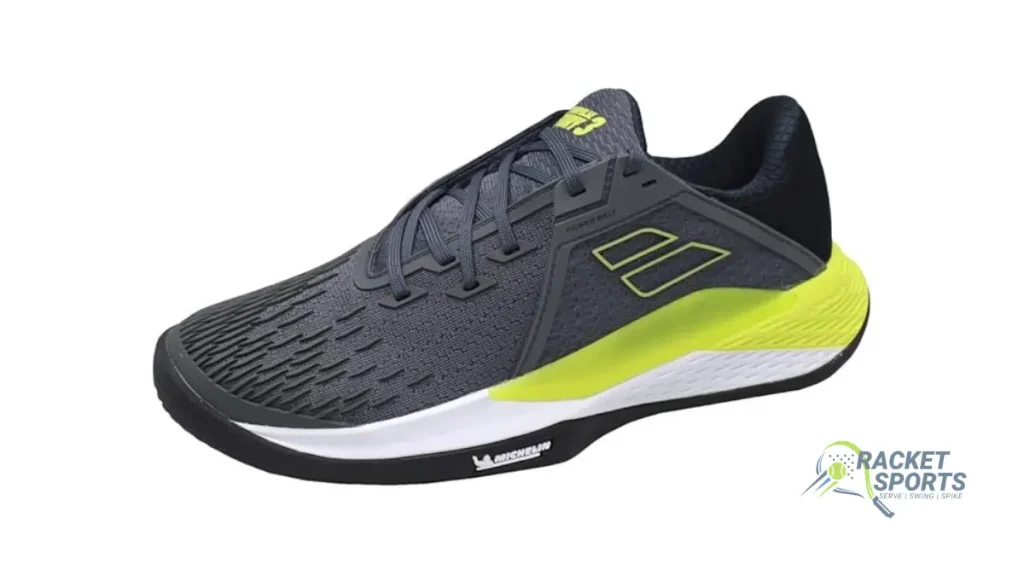
4.4
Specifications:
Key Features
- Michelin® Outsole: Offers exceptional grip and durability, especially on clay courts.
- KPRS-X Cushioning: Absorbs shock and reduces impact.
- Power Belt Strap: Provides excellent midfoot support.
- S-BLOCK Technology: Enhances lateral stability and control.
The Propulse Fury 3 features a Michelin®-branded outsole, offering excellent grip on clay courts without premature balding. The KPRS-X brace minimizes rollover risks, providing stability during lateral movements. This shoe is designed for players who demand durability and support during intense matches.
Ideal for: Hard-hitting players who demand robust footwear capable of withstanding intense play and providing ample support.
Pros & Cons:
6. Wilson Rush Pro 4.5 – Best All-Court Versatility
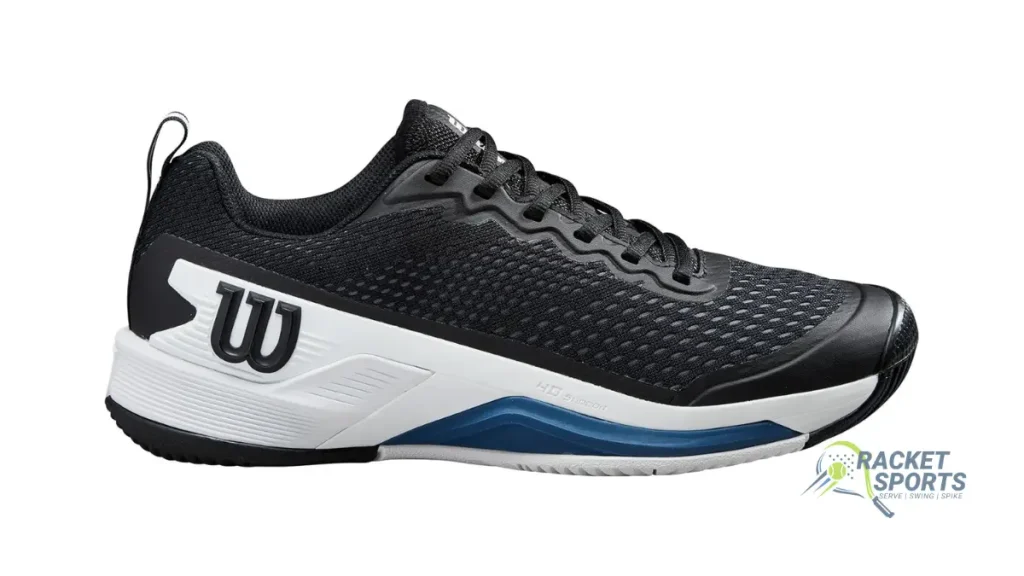
4.4
Specifications:
Key Features
- 3D-FS Technology: Adapts to various court surfaces for consistent performance.
- Endofit™ Sleeve: Provides a glove-like fit for enhanced comfort.
- Duralast Outsole: Ensures durability and traction.
- Ortholite® Sockliner: Offers moisture-wicking properties and cushioning.
The Rush Pro 4.5 is versatile, adapting to various court surfaces. Its 3D-FS technology offers stability during lateral movements, while the Ortholite sockliner wicks moisture, keeping feet dry during long matches. The shoe’s design ensures comfort and support, making it suitable for players who play on different court types.
Ideal for: All-court players seeking a balance of comfort, stability, and responsiveness across various playing surfaces.
Pros & Cons:
7. K-Swiss Hypercourt Supreme 2 – Best Comfort
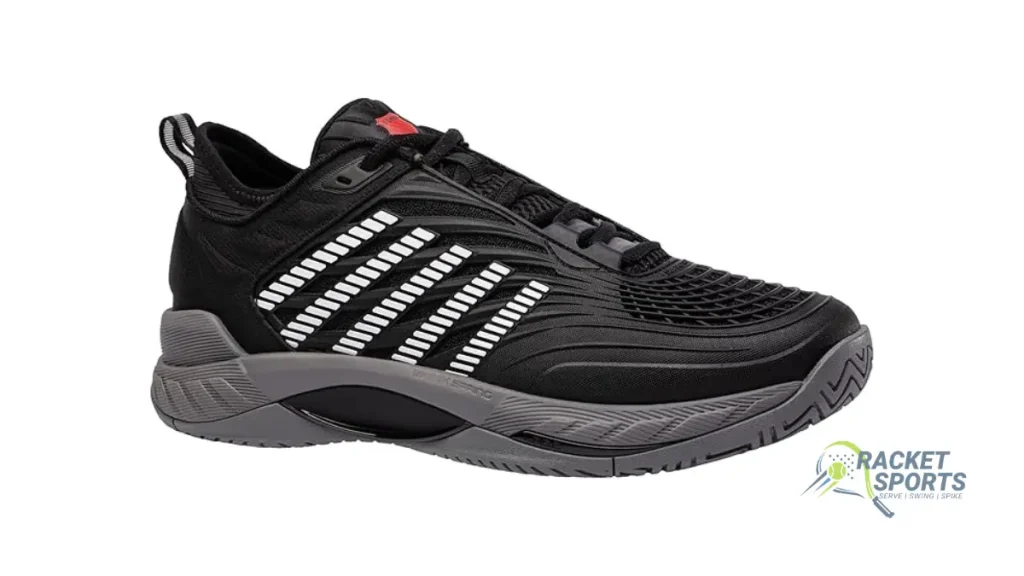
3.8
Specifications:
Key Features
- Surgelite Midsole: Provides lightweight cushioning and support.
- Shock Spring Foam: Enhances forefoot responsiveness.
- Dragguard 7.0 Outsole: Offers durability and traction on all court surface
- Durawrap X Upper: Provides flexible drag protection.
The Hypercourt Supreme 2 prioritizes comfort with its breathable AOSTA 7.0 compound that molds to high arches. The 360° Plantar Support System eases plantar fasciitis symptoms, providing relief during play. Its lightweight design and supportive structure make it ideal for players seeking comfort during matches.
Ideal for: Players with wider feet or those prone to foot discomfort, looking for a comfortable and supportive shoe.
Pros & Cons:
8. On ROGER Pro 2 – Best Traction
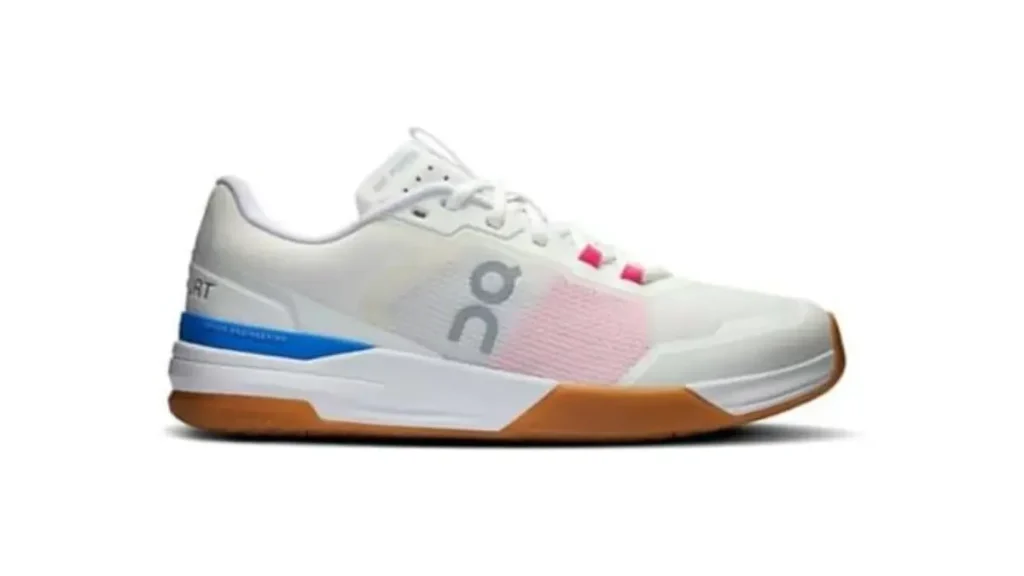
NEW
Specifications:
Key Features
- Speedboard® Plate: Facilitates explosive toe-offs.
- Hybrid Outsole Tread: Offers grip on both clay and hard courts.
- Lightweight Construction: Ensures agility and comfort.
- Sock-Like Fit: Provides a snug and supportive feel.
The ROGER Pro 2 features Speedboard® technology, creating a snappy toe-off for quick movements. Its hybrid clay/hard court tread pattern grips loose surfaces, providing excellent traction. This shoe is designed for players who prioritize grip and stability during matches.
Ideal for: Players who prioritize traction and agility, suitable for both casual and competitive play.
Pros & Cons:
9. Lacoste AG-LT23 Ultra – Best Style
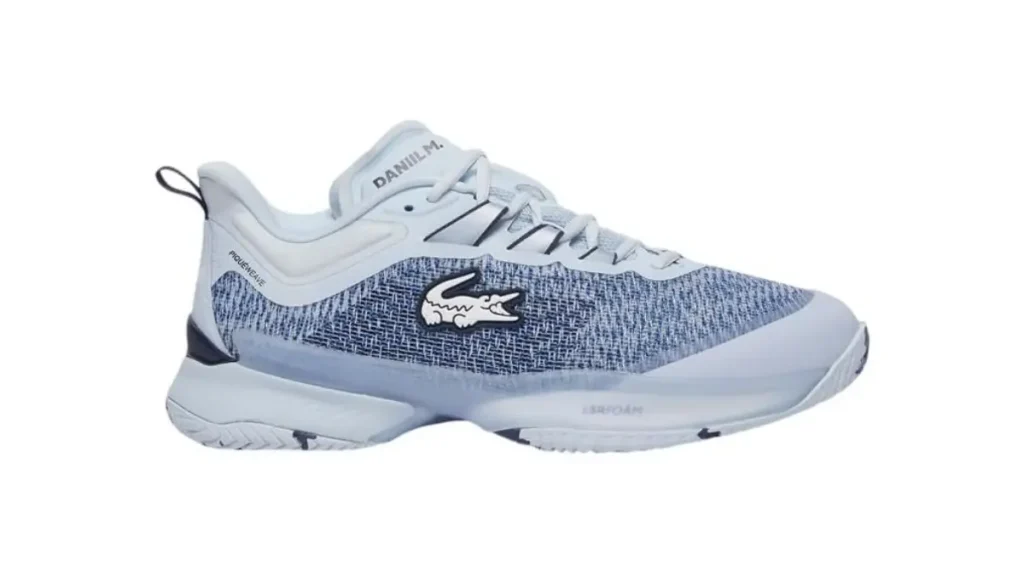
5.0
Specifications:
Key Features
- Full-Grain Leather Upper: Offers a premium look and feel.
- Thermo-Regulating Lining: Keeps feet cool and dry.
- Couture-Inspired Design: Combines fashion-forward aesthetics with performance.
- ITF Compliance: Meets international tennis footwear standards.
The AG-LT23 Ultra combines performance with style. Its full-grain leather uppers with thermo-regulating lining offer a premium look and feel. The couture-inspired color blocks meet ITF compliance standards, ensuring both aesthetics and functionality. This shoe is perfect for players who value style without compromising on performance.
Ideal for: Style-conscious players seeking a blend of fashion and function, without compromising on performance.
Pros & Cons:
How to Choose the Right Tennis Shoes
Selecting the appropriate tennis shoes is crucial for enhancing your performance and preventing injuries. The right pair not only complements your playing style but also aligns with the specific demands of the court surface. Here’s a detailed breakdown to guide you:
1. Identify Your Playing Style
Understanding your movement and playstyle is the first step in choosing the right tennis shoes:
- Agile Players: If you’re quick on your feet, frequently changing directions and covering the court with speed, look for shoes that offer lightweight construction and responsive cushioning. These features will support rapid movements and provide the necessary agility.
- Aggressive Baseliners: For players who engage in powerful groundstrokes and spend considerable time at the baseline, stability and durability are paramount. Opt for shoes with enhanced lateral support and robust outsoles to withstand the rigors of intense play.
- Serve-and-Volley Players: Those who approach the net frequently require shoes that offer excellent traction for quick starts and stops, as well as cushioning to absorb the impact from high-speed movements.
2. Consider the Court Surface
Different court surfaces demand specific shoe features to optimize performance:
Hard Court Tennis Shoes
- Court Characteristics: Hard courts are typically made of concrete or asphalt with an acrylic top, offering a fast-paced game with high traction. However, they can be tough on both the body and footwear due to their unforgiving nature.
- Outsole Features: Look for shoes with a multi-directional tread pattern that provides both grip and the ability to slide when necessary. The outsole should be durable to withstand the abrasive surface.
Clay Court Tennis Shoes
- Court Characteristics: Clay courts are made of crushed brick, stone, or shale, offering a slower-paced game with higher bounces. They are gentler on the body and shoes but can be slippery.
- Outsole Features: A full herringbone tread pattern is essential for clay court shoes, as it allows for sliding and prevents the collection of clay dust. The outsole should also be designed to release clay easily to maintain traction.
Grass Court Tennis Shoes
- Court Characteristics: Grass courts provide a fast-paced game with a low bounce. The surface can be slippery, especially when wet, requiring shoes that offer superior grip.
- Outsole Features: Grass court shoes typically feature “nubs” or “pimples” on the outsole, similar to cleats, to provide traction without damaging the turf. The outsole should be flat to prevent marking the court.
All-Court Tennis Shoes
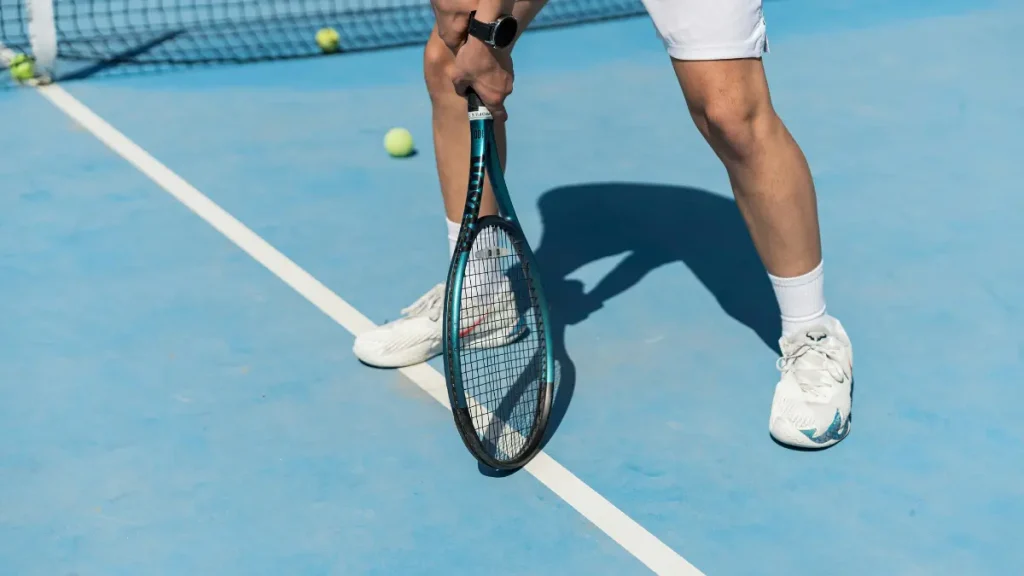
- Versatility: All-court shoes are designed to perform well on various surfaces, making them a convenient choice for players who frequently switch between different court types.
- Outsole Features: These shoes typically feature a modified herringbone pattern that offers a balance of grip and durability across multiple surfaces.
Additional Factors to Consider
Beyond playing style and court surface, other factors play a significant role in selecting the right tennis shoes:
Fit and Comfort
- Proper Fit: Ensure there is about a half-inch space between your longest toe and the front of the shoe. The shoe should fit snugly around the midfoot and heel to prevent slipping.
- Arch Support: Choose shoes that provide adequate arch support based on your foot type (flat, neutral, or high arch) to prevent discomfort and potential injuries.
Cushioning and Support
- Cushioning: Look for shoes with sufficient cushioning to absorb shock, especially if you play on hard courts. This will reduce the impact on your joints and provide comfort during long matches.
- Stability: Shoes with a stable base and lateral support are crucial for preventing ankle injuries, particularly for players who engage in quick direction changes.
Durability
- Outsole Durability: Consider shoes with durable outsoles, especially if you play frequently. Some models offer extended durability warranties, indicating their longevity.
- Upper Material: The upper material should be robust yet breathable, allowing for comfort during extended play while withstanding the wear and tear of the game.
Choosing the right tennis shoes involves considering your playing style, the court surface, and additional factors like fit, cushioning, and durability. By selecting shoes tailored to these aspects, you can enhance your performance, comfort, and longevity on the court. Remember, investing in quality footwear is investing in your game.
Tennis Shoe Buying Guide: Key Considerations
Choosing the right tennis shoes is crucial for enhancing your performance on the court and preventing injuries. Your selection should align with the court surface you play on and your individual playing style and foot type.
Court Surface Compatibility
Different court surfaces demand specific shoe features to ensure optimal grip, durability, and comfort.
Hard Court Shoes
Hard courts are the most common and also the most demanding on footwear. They require shoes with durable outsoles and adequate cushioning to absorb the impact of the hard surface. Look for shoes featuring herringbone or modified zig-zag tread patterns made from XDR (Extra Durable Rubber) compounds.
These patterns provide a balance between grip and slide, essential for quick lateral movements. The Asics Gel Resolution 9 is a standout choice, offering excellent durability and support for hard court players.
Clay Court Shoes
Clay courts require shoes that can handle the softer, more slippery surface. Opt for shoes with full-length herringbone tread patterns, which help in providing the necessary grip and also prevent clay from clogging the outsole. This design facilitates controlled sliding and quick stops.
Playing Style and Foot Type
Your playing style and foot structure significantly influence the type of tennis shoes that will best support your game.
Aggressive Movers
Players who engage in intense, rapid movements across the court need shoes that offer superior torsional control and stability. Features like reinforced midsoles and durable outsoles are essential to withstand the high demands of aggressive play. The Adidas Barricade series is renowned for its robust construction and support, making it a favorite among aggressive players.
Flat Feet
Individuals with flat feet require shoes that provide enhanced arch support to prevent overpronation and associated injuries. Look for models with medial posts or structured arch support systems..
Additional Tips for Selecting Tennis Shoes
- Fit and Comfort: Ensure the shoes fit snugly without being too tight. There should be enough room in the toe box to prevent cramping, and the heel should be secure to avoid slippage.
- Cushioning: Adequate cushioning helps in shock absorption, reducing stress on your joints during play. Consider shoes with gel-based or air-cushioning systems for added comfort.
- Durability: If you play frequently, especially on hard courts, opt for shoes with durable outsoles and consider brands that offer outsole warranties.
- Weight: Lighter shoes can enhance speed and agility, while heavier shoes often provide more support and stability. Choose according to your playing style and personal preference.
Selecting the right tennis shoes involves considering the court surface, your playing style, and foot structure. By paying attention to these factors, you can find a pair that not only enhances your performance but also keeps you comfortable and injury-free on the court
Expert Tips for Maximizing Tennis Shoe Performance
Proper Break-In Techniques
Breaking in a new pair of tennis shoes is essential to ensure comfort and prevent injuries on the court. Rather than jumping straight into intense matches, it’s advisable to ease into wearing them. Start by donning your new shoes around the house for short periods—about 1 to 2 hours daily—for a week. This gradual approach allows the materials to adapt to the contours of your feet, reducing the risk of blisters and discomfort.
Incorporating thick socks during this phase can aid in stretching the shoes slightly, providing a snug yet comfortable fit. Additionally, focusing on flexing your toes and walking on various surfaces can help soften the forefoot zones, enhancing flexibility where it’s most needed.
Some players also recommend using a hairdryer to gently warm tight areas, making the material more pliable. However, always exercise caution with heat to avoid damaging the shoe’s integrity.
Remember, patience is key. Rushing the break-in process can lead to unnecessary discomfort and potential injuries. By allowing your shoes to conform naturally to your feet, you’ll set the foundation for optimal performance on the court.
When to Replace Your Tennis Shoes
Tennis shoes, like any athletic gear, have a lifespan that directly impacts performance and injury prevention. A general guideline suggests replacing your tennis shoes every 45 to 60 hours of play.
For recreational players hitting the court once or twice a week, this typically translates to a new pair every 6 to 12 months. However, several factors can influence this timeline, including playing style, court surface, and shoe construction.
Key indicators that it’s time for a replacement include:
- Worn Outsoles: If the tread depth reaches approximately 1mm or shows uneven wear patterns, traction and stability are compromised.
- Reduced Cushioning: A noticeable decrease in shock absorption can lead to increased stress on joints, potentially causing discomfort or injury.
- Visible Damage: Tears, holes, or significant creasing in the upper material can affect the shoe’s support and fit.
To extend the lifespan of your footwear, consider rotating between two pairs of tennis shoes. This practice allows each pair adequate time to decompress and dry out between uses, maintaining their structural integrity and comfort.
Ultimately, listening to your body is crucial. If you begin to experience unusual aches, decreased performance, or discomfort during play, it may be a sign that your shoes are no longer providing the necessary support. Regularly assessing the condition of your tennis shoes ensures you remain at the top of your game while minimizing the risk of injury.
Frequently Asked Questions
How often should I replace my tennis shoes?
Pros replace shoes every 4-6 weeks; recreational players every 4-6 months. Measure tread wear and midsole compression.
Can I use running shoes for tennis?
No, it’s not recommended. Because Running shoes are designed for forward motion and lack the lateral support needed for tennis. Using them can increase the risk of ankle rolls and other injuries during side-to-side movements. Additionally, running shoes may mark up hard courts with black streaks, which is often prohibited.
What’s the difference between men’s and women’s tennis shoes?
Women’s models are typically 1.5mm narrower in the heel with higher arches. Cushioning is often softer.
How do I know when my tennis shoes have lost their performance?
Beyond visual wear, consider the following:
Decreased comfort: If you experience foot pain or discomfort during play.
Reduced responsiveness: Noticeable lack of bounce or energy return.
Instability: Feeling less stable during lateral movements or quick direction changes.
These signs indicate that your shoes may no longer provide the necessary support and cushioning.
Can I use tennis shoes for other sports?
Tennis shoes are specifically designed for the demands of tennis, including lateral support and durability on court surfaces. Using them for other sports may not provide the appropriate support and could lead to discomfort or injury. It’s advisable to use sport-specific footwear for optimal performance and safety.
Conclusion: Step Up Your Game With the Right Shoes
Choosing the right tennis shoes isn’t just about style—it’s a crucial decision that can significantly impact your performance, comfort, and long-term joint health. The top 9 best tennis shoes for men we’ve highlighted cater to various playing styles and court surfaces, ensuring that every player finds a pair that aligns with their specific needs.
For players who thrive on hard courts, the ASICS Gel Resolution 9 stands out as a premier choice. Renowned for its exceptional stability and cushioning, this shoe is designed to support aggressive lateral movements, thanks to features like the DYNAWALL technology and a robust exoskeleton.
Its FlyteFoam midsole combined with GEL padding offers superior shock absorption, making it ideal for players who demand both comfort and performance during intense matches.
On the other hand, if clay courts are your battleground, the Babolat Propulse Fury 3 is tailored to meet the demands of the surface. This shoe boasts a reengineered sole that provides a bucket-seat-like feel around the heel, ensuring maximum stability during rapid directional changes.
The collaboration with Michelin has resulted in a sole that offers optimal grip and durability, allowing players to slide and pivot with confidence. Additionally, the KPRS-X 2 system cushions the heel with EVA foam, adept at absorbing shocks, which is essential for the dynamic movements on clay courts.
Investing in tennis shoes that align with your biomechanics and playing style is more than just a comfort decision—it’s a strategic move to enhance your game and protect your body. Whether you’re a baseline grinder or a serve-and-volley enthusiast, selecting the right footwear can make a significant difference in your performance and enjoyment of the game.
